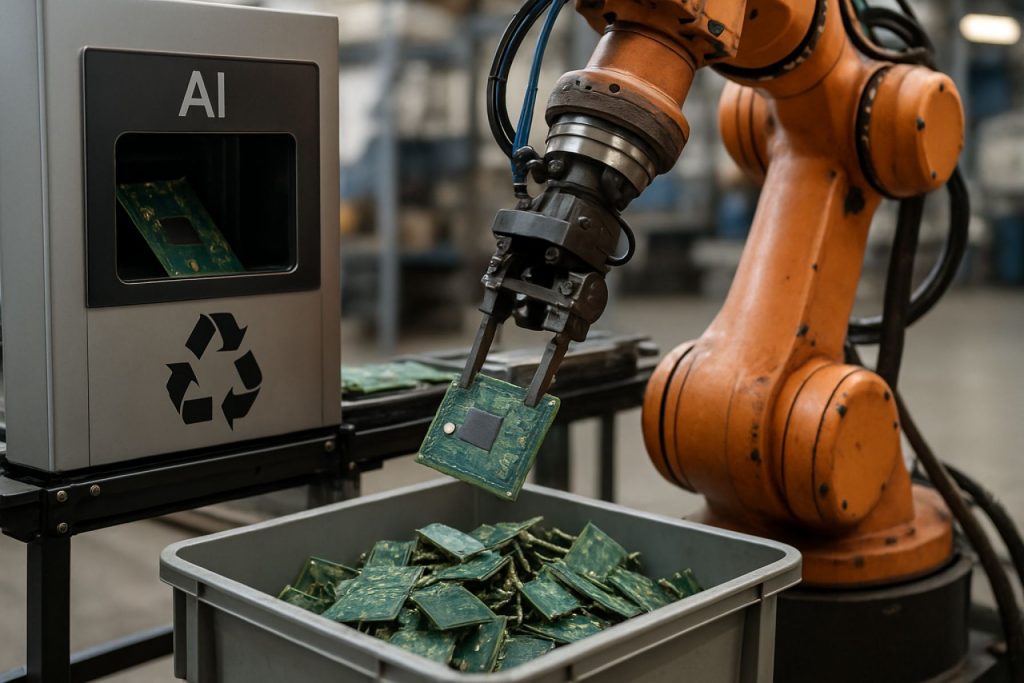
Rare Earth Element Recycling Automation Market Report 2025: Unveiling Growth Drivers, AI Innovations, and Global Opportunities. Explore Market Size, Leading Players, and Strategic Forecasts for the Next 5 Years.
- Executive Summary & Market Overview
- Key Technology Trends in Rare Earth Element Recycling Automation
- Competitive Landscape and Leading Players
- Market Growth Forecasts (2025–2030): CAGR, Volume, and Value Analysis
- Regional Analysis: North America, Europe, Asia-Pacific, and Rest of World
- Challenges and Opportunities in Automated Rare Earth Recycling
- Future Outlook: Strategic Recommendations and Emerging Trends
- Sources & References
Executive Summary & Market Overview
The global push for sustainable resource management and the surging demand for rare earth elements (REEs) in high-tech industries are driving rapid advancements in rare earth element recycling automation. Rare earth elements, essential for manufacturing electronics, renewable energy technologies, and electric vehicles, face supply chain vulnerabilities due to geopolitical concentration and environmentally intensive mining processes. As of 2025, the market for automated REE recycling solutions is experiencing accelerated growth, propelled by both regulatory pressures and technological innovation.
Automated recycling systems leverage robotics, artificial intelligence, and advanced sensor technologies to efficiently extract and separate REEs from end-of-life products such as magnets, batteries, and electronic waste. These systems address critical challenges in manual recycling, including labor intensity, inconsistent recovery rates, and hazardous working conditions. Automation not only enhances material recovery efficiency but also reduces operational costs and environmental impact, making it a strategic priority for manufacturers and recyclers alike.
According to Allied Market Research, the global rare earth metals market is projected to reach $9.6 billion by 2026, with recycling expected to account for a growing share of supply. The integration of automation is anticipated to further boost recycling rates, with the International Energy Agency (International Energy Agency) highlighting automated recycling as a key enabler for securing critical mineral supply chains. In 2025, leading technology providers and recycling firms are investing in automated disassembly lines, AI-driven sorting systems, and closed-loop recovery processes to capture value from electronic and industrial waste streams.
Regionally, Europe and East Asia are at the forefront of adopting automated REE recycling, driven by stringent environmental regulations and ambitious circular economy targets. The European Commission’s Critical Raw Materials Act and China’s national recycling initiatives are catalyzing investments in automation technologies. North America is also witnessing increased activity, with public-private partnerships supporting the deployment of advanced recycling infrastructure.
In summary, rare earth element recycling automation in 2025 represents a convergence of market necessity, regulatory momentum, and technological progress. The sector is poised for robust expansion, with automation emerging as a linchpin for sustainable, resilient, and economically viable REE supply chains worldwide.
Key Technology Trends in Rare Earth Element Recycling Automation
Rare earth element (REE) recycling automation is rapidly evolving, driven by the urgent need to secure critical material supply chains and reduce environmental impact. In 2025, several key technology trends are shaping the automation of REE recycling processes, with a focus on efficiency, scalability, and sustainability.
- Advanced Sensor-Based Sorting: Automation systems increasingly leverage sophisticated sensor technologies, such as X-ray fluorescence (XRF), laser-induced breakdown spectroscopy (LIBS), and hyperspectral imaging, to identify and separate REE-containing components from electronic waste and end-of-life products. These sensors enable real-time, high-throughput sorting, significantly improving material recovery rates and purity levels. Companies like TOMRA are pioneering sensor-based sorting solutions that are being adapted for REE recycling applications.
- Robotics and AI-Driven Disassembly: Automated robotic systems, guided by artificial intelligence (AI), are being deployed to disassemble complex products such as electric vehicle batteries, wind turbine magnets, and consumer electronics. These systems can identify, extract, and sort REE-rich components with minimal human intervention, reducing labor costs and exposure to hazardous materials. ABB and FANUC are among the industrial automation leaders integrating AI and robotics into recycling lines.
- Closed-Loop Process Automation: End-to-end automation of hydrometallurgical and pyrometallurgical recycling processes is gaining traction. Automated control systems monitor and optimize chemical leaching, solvent extraction, and precipitation steps, ensuring consistent recovery yields and minimizing reagent consumption. Siemens and Honeywell are developing process automation platforms tailored for critical material recycling.
- Digital Twin and Predictive Analytics: The integration of digital twin technology allows operators to simulate and optimize recycling plant operations virtually, reducing downtime and improving process efficiency. Predictive analytics, powered by machine learning, help anticipate equipment failures and optimize maintenance schedules, further enhancing automation reliability. GE Digital and AVEVA are at the forefront of deploying these digital solutions in industrial recycling.
These technology trends are collectively enabling the scale-up of REE recycling, supporting the circular economy and reducing dependence on primary mining. As automation matures, industry stakeholders anticipate further cost reductions and higher recovery rates, positioning automated REE recycling as a cornerstone of sustainable supply chains in 2025 and beyond (International Energy Agency).
Competitive Landscape and Leading Players
The competitive landscape for rare earth element (REE) recycling automation in 2025 is characterized by a dynamic mix of established industrial automation firms, specialized recycling technology companies, and emerging startups. The sector is driven by the urgent need to secure sustainable REE supply chains, reduce environmental impact, and comply with increasingly stringent regulations on electronic waste and resource recovery.
Leading players in this market are leveraging advanced robotics, artificial intelligence (AI), and machine learning to automate the identification, separation, and extraction of rare earth elements from end-of-life products such as electronics, magnets, and batteries. Siemens AG and ABB Ltd. are notable for integrating their industrial automation platforms with specialized recycling modules, enabling high-throughput and precise material recovery. These companies are collaborating with recycling operators to deploy scalable, modular systems that can be adapted to various waste streams.
Specialized technology firms such as Umicore and Urban Mining Company are at the forefront of developing proprietary processes for automated REE extraction. Umicore, for example, has invested in AI-driven sorting and hydrometallurgical techniques to maximize recovery rates from complex waste. Urban Mining Company focuses on closed-loop recycling of rare earth magnets, utilizing automated disassembly and separation technologies to reclaim neodymium, dysprosium, and other critical elements.
Startups and research-driven ventures are also shaping the competitive landscape. Companies like Recycle Technology and Neo Performance Materials are piloting robotic systems capable of dismantling and sorting electronic components with minimal human intervention. These innovations are often supported by government grants and partnerships with academic institutions, reflecting the strategic importance of REE recycling for national resource security.
Strategic alliances, joint ventures, and technology licensing agreements are common as companies seek to accelerate commercialization and expand their geographic reach. The competitive intensity is further heightened by the entry of Asian players, particularly from China and Japan, who are investing heavily in automation to address domestic supply chain vulnerabilities and export restrictions (International Energy Agency).
Overall, the 2025 market for rare earth element recycling automation is marked by rapid technological innovation, cross-sector collaboration, and a race to achieve cost-effective, high-purity recovery at scale.
Market Growth Forecasts (2025–2030): CAGR, Volume, and Value Analysis
The market for rare earth element (REE) recycling automation is poised for robust growth between 2025 and 2030, driven by escalating demand for sustainable supply chains and the increasing adoption of advanced robotics and AI in recycling processes. According to projections by Allied Market Research, the global rare earth metals market is expected to reach $5.5 billion by 2030, with recycling automation representing a rapidly expanding segment within this market.
From 2025 to 2030, the compound annual growth rate (CAGR) for REE recycling automation is forecasted to exceed 12%, outpacing the broader rare earth recycling sector. This acceleration is attributed to several factors:
- Technological Advancements: The integration of machine learning, robotics, and sensor-based sorting is significantly improving the efficiency and yield of REE recovery from end-of-life electronics and industrial waste streams. Companies such as Umicore and Urban Mining Company are investing heavily in automated systems to scale up operations and reduce manual labor costs.
- Policy and Regulatory Support: Stringent environmental regulations in the EU, US, and East Asia are incentivizing the adoption of closed-loop recycling systems, further fueling demand for automation solutions. The European Commission has set ambitious targets for critical raw material recycling, directly impacting market growth.
- Supply Chain Security: Geopolitical tensions and supply risks associated with primary REE mining are prompting manufacturers in the automotive, electronics, and renewable energy sectors to invest in automated recycling as a strategic alternative.
In terms of volume, automated REE recycling facilities are projected to process over 25,000 metric tons of end-of-life products annually by 2030, a significant increase from the estimated 8,000 metric tons in 2025 (Adamas Intelligence). The value generated by automation in this segment is expected to surpass $1.2 billion by 2030, reflecting both the premium on recovered materials and the cost savings from process optimization.
Overall, the period from 2025 to 2030 will see rare earth element recycling automation transition from pilot-scale deployments to mainstream industrial adoption, underpinned by technological innovation, regulatory momentum, and the imperative for resource security.
Regional Analysis: North America, Europe, Asia-Pacific, and Rest of World
The regional landscape for rare earth element (REE) recycling automation in 2025 is shaped by varying levels of technological maturity, regulatory frameworks, and supply chain imperatives across North America, Europe, Asia-Pacific, and the Rest of the World.
- North America: The United States and Canada are accelerating investments in automated REE recycling, driven by national security concerns and the need to reduce reliance on imports. The U.S. Department of Energy has funded pilot projects integrating robotics and AI for efficient sorting and extraction from end-of-life electronics and magnets. Companies such as American Manganese Inc. are deploying proprietary hydrometallurgical processes with automation to scale up operations. The region benefits from a robust tech ecosystem and government incentives, but faces challenges in establishing a consistent feedstock supply and scaling up to commercial levels.
- Europe: The European Union’s Circular Economy Action Plan and Critical Raw Materials Act are catalyzing the adoption of advanced automation in REE recycling. Countries like Germany, France, and Sweden are home to pilot plants utilizing AI-driven sorting, robotic disassembly, and closed-loop hydrometallurgical systems. Umicore and Solvay are leading industry players integrating automation to improve recovery rates and reduce environmental impact. The EU’s regulatory push and funding for innovation are expected to make Europe a leader in automated REE recycling by 2025.
- Asia-Pacific: China, Japan, and South Korea dominate the global REE supply chain and are rapidly automating recycling processes to secure domestic supply and address environmental concerns. China’s state-backed enterprises, such as Chinalco, are investing in AI-powered sorting and automated hydrometallurgical plants. Japan’s Hitachi and Toshiba are pioneering robotic disassembly lines for end-of-life electronics. The region’s strong manufacturing base and government mandates are accelerating the deployment of automation, though environmental compliance and technology transfer remain ongoing challenges.
- Rest of World: Other regions, including Australia, Africa, and Latin America, are in the early stages of adopting REE recycling automation. Australia, with its significant mining sector, is exploring automated recycling as part of its critical minerals strategy, with support from organizations like CSIRO. However, limited infrastructure and investment constrain rapid adoption elsewhere, though partnerships with technology leaders in Europe and Asia-Pacific are emerging.
Overall, 2025 will see North America and Europe advancing in automated REE recycling through policy support and innovation, while Asia-Pacific leverages its industrial scale and supply chain dominance. The Rest of the World is expected to follow, driven by resource security and international collaboration.
Challenges and Opportunities in Automated Rare Earth Recycling
Automated rare earth element (REE) recycling is emerging as a critical solution to address both supply chain vulnerabilities and environmental concerns associated with traditional mining. However, the sector faces a unique set of challenges and opportunities as it moves toward broader adoption in 2025.
Challenges
- Technological Complexity: Automated systems must efficiently identify, extract, and separate REEs from complex end-of-life products such as electronics and magnets. The heterogeneity of feedstock and the minute quantities of REEs present require advanced robotics, machine vision, and AI-driven sorting, which are still under development and can be cost-prohibitive for many recyclers (International Energy Agency).
- Economic Viability: The high capital expenditure for automation infrastructure, coupled with fluctuating REE market prices, can make it difficult for recycling operations to achieve profitability. The cost of collection, transportation, and processing often outweighs the value of recovered materials, especially when compared to primary extraction in countries with lower labor costs (Adamas Intelligence).
- Regulatory and Supply Chain Barriers: Inconsistent regulations across regions and a lack of standardized recycling protocols hinder the development of scalable automated solutions. Additionally, the fragmented nature of e-waste collection limits the steady supply of recyclable material necessary for continuous automated operations (United Nations Environment Programme).
Opportunities
- Technological Innovation: Advances in sensor technology, AI, and robotics are rapidly improving the efficiency and selectivity of automated recycling systems. Companies investing in R&D are poised to benefit from first-mover advantages as these technologies mature (BASF).
- Policy Support and Funding: Governments in the EU, US, and Asia are introducing incentives, grants, and mandates to promote circular economy practices, including automated REE recycling. These policies are expected to lower financial barriers and stimulate market growth in 2025 (European Commission).
- Strategic Partnerships: Collaborations between technology providers, manufacturers, and recyclers are accelerating the deployment of automated systems. Such partnerships can help secure feedstock, share R&D costs, and create closed-loop supply chains, enhancing both economic and environmental outcomes (Umicore).
In summary, while automated REE recycling faces significant hurdles in 2025, ongoing innovation, supportive policy frameworks, and industry collaboration are creating a fertile environment for growth and long-term impact.
Future Outlook: Strategic Recommendations and Emerging Trends
The future of rare earth element (REE) recycling automation is poised for significant transformation in 2025, driven by technological advancements, regulatory pressures, and the urgent need for supply chain resilience. As global demand for REEs intensifies—particularly for use in electric vehicles, wind turbines, and advanced electronics—automated recycling solutions are emerging as a critical strategy to supplement primary mining and reduce environmental impact.
Strategic Recommendations:
- Invest in Advanced Sorting and Separation Technologies: Companies should prioritize the integration of AI-powered robotics, sensor-based sorting, and hydrometallurgical automation to improve recovery rates and reduce operational costs. Early adopters of these technologies, such as Umicore and Urban Mining Company, are already demonstrating improved efficiency and scalability in REE recycling.
- Forge Strategic Partnerships: Collaboration between recyclers, OEMs, and technology providers can accelerate the development and deployment of automated systems. Joint ventures and public-private partnerships, as seen in initiatives supported by the U.S. Department of Energy, can help share risks and pool expertise.
- Focus on Closed-Loop Supply Chains: Automating the collection and processing of end-of-life products—such as magnets from electronics and electric vehicles—enables a circular economy model. Companies should work closely with manufacturers to design products for easier disassembly and material recovery.
- Monitor Regulatory Developments: With the European Union and other regions tightening e-waste and critical material recycling mandates, staying ahead of compliance requirements will be essential. Proactive engagement with policymakers can also help shape favorable regulatory frameworks.
Emerging Trends:
- AI and Machine Learning Integration: The use of machine vision and predictive analytics is streamlining the identification and extraction of REEs from complex waste streams, as highlighted in recent pilot projects by Hitachi and Sims Limited.
- Decentralized Micro-Recycling Facilities: Modular, automated recycling units are being deployed closer to waste generation points, reducing transportation costs and emissions. This trend is supported by innovations from companies like Neometals.
- Blockchain for Traceability: Blockchain-enabled platforms are being piloted to ensure transparency and traceability in recycled REE supply chains, addressing concerns over material provenance and quality.
In summary, 2025 will see rare earth element recycling automation move from pilot to scale, with strategic investments and cross-sector collaboration key to unlocking its full potential and securing critical material supply for the green economy.
Sources & References
- Allied Market Research
- International Energy Agency
- Critical Raw Materials Act
- Siemens
- Honeywell
- GE Digital
- AVEVA
- Umicore
- Neo Performance Materials
- American Manganese Inc.
- Chinalco
- Hitachi
- Toshiba
- CSIRO
- United Nations Environment Programme
- BASF
- Sims Limited
- Neometals



